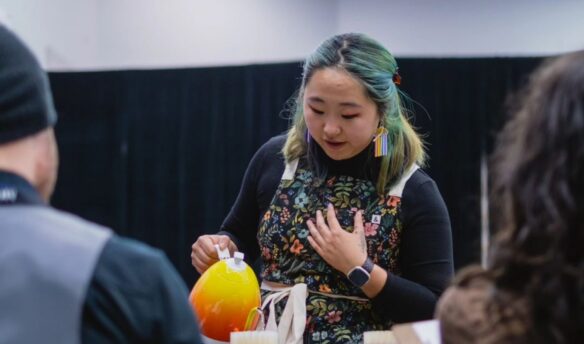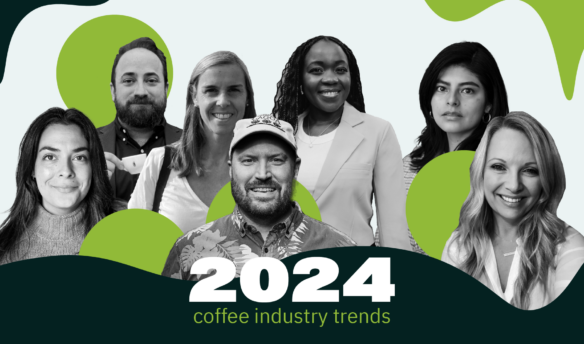Jessica Easto is used to making complex things accessible. In 2017, the author and editor published “Craft Coffee: A Manual,” a guide to making better coffee at home that we once described as “Eliminat[ing] the intimidation factor from manual brewing. . . . This guide offers value for new cafés or novice baristas, as well as the casual consumer.”
Her latest book tackles tasting coffee with the same lens. In “How to Taste Coffee: Develop Your Sensory Skills and Get the Most Out of Every Cup,” out October 24, 2023, Easto breaks down the science behind how we drink coffee and encourages readers to become more mindful sippers through simple exercises and jargon-free language, yet still manages to provide an incredibly comprehensive overview of how our brain and senses work together to produce flavor.
The book, available for pre-order now, left us buzzing, examining how we taste coffee and talk to others about what we’re experiencing. We got to chat with Easto about some of the big ideas behind the book, including the difference between taste and flavor, how cool mouths are, and why you might actually have a more developed sense of smell than your four-legged friends.
Fresh Cup: Can you talk about the difference between taste and flavor? Can you talk about the relationship between flavor and quality?
Jessica Easto: Taste is the perception that results when a taste molecule interacts with a taste receptor in your mouth. This results in one of five perceptions, which we call the basic tastes: bitter, sweet, salty, sour, and umami. Flavor is our brain’s synthesis of all sensory inputs, but primarily taste, smell, and touch. According to the Specialty Coffee Association, flavor is quality. Specialty coffee is scored based on specific desired flavor qualities (and the absence of undesirable flavor qualities).
You mention that “language is the biggest hurdle we consumers face when it comes to identifying the coffee we like to drink.” What’s an example of how language has been a hurdle, and why does this problem persist?
With other types of food and drink, consumers tend to buy things based on descriptions of how things taste, and for the most part, those words align with expectations. Many specialty coffees are described with language we call flavor notes, and many consumers make purchases based on these notes. However, I’d argue that they rarely reflect what a consumer is expecting when they buy them.
There are a few reasons for this. First, coffee flavor is tricky, simply put. Everything affects its flavor, including how it was grown, processed, roasted, and brewed. Many flavor notes are created when a roaster cups coffee—so the notes are created on a specific day using a specific type of roast and brewing method (often cupping) that does not necessarily reflect how it will be brewed in the field. On that note (haha), coffee is singularly unique in that it must be “finished” in the moment—and one of its two ingredients (water) can vary greatly from location to location. Brewing, age, and water all affect flavor.
Second, the dimensions of coffee flavor (I’m talking about the notes that exist in addition to the distinct flavor we know as “coffee”) tend to be subtle, and some require some practice—or at least mindfulness—to taste.
Third, we don’t have a common coffee vocabulary. The beginning of one does exist in World Coffee Research’s Sensory Lexicon, which ties experiences (references you can taste/smell) to vocabulary so we can all be on the same page about what to call something. But in my experience, these terms are not widely used in the marketing material that reaches consumers. Instead, we have roasters describing perhaps the same note in a multitude of ways, so it’s very difficult for consumers to find their footing.
Why do flavor notes let us down? Specifically, how do specific flavor notes let us down?
Specific flavor notes let us down when we cannot connect them to a shared sensory experience or when it’s not clear what sensory experience is being described. For example, a hibiscus flavor note is useless to a consumer unless that consumer knows what hibiscus tastes like. Pink lemonade has the potential to be informative because many people have tasted pink lemonade (in the US market, more than hibiscus, I would guess), but when you think about it, it’s nebulous because most pink lemonade is just regular lemonade that has been dyed pink—so what is the word pink trying to communicate?
Effervescent is perhaps the worst offender in this example. The word effervescent means something has or produces bubbles, like carbonated water. But the coffee I took these notes from was not carbonated. So what is a consumer supposed to do with that? Many might take it literally, but even if you know not to, you’re left to guess what it means, and what you guess will be based on your personal experiences.
Sometimes, it seems like roasters put highly specific flavor notes on the bag either to impress other coffee people or to make something sound appealing to consumers. But when that appeal is not tied to anything concrete—or can be interpreted many ways—it becomes ineffective or even misleading.
You mention, “Our mouths are about as sensitive to touch as our fingertips, and our tongues are more sensitive to temperature than any other part of our bodies.” Mouths seem pretty cool. Are there other wild facts you learned about how we experience taste and flavor?
I didn’t know much about taste or flavor before researching for the book, so all of it was fascinating and made me appreciate the sheer awesomeness of our bodies. I was really interested to learn just how powerful our sense of smell is, which I learned has historically been underappreciated because we have fewer olfactory receptors than other mammals.
But we use a big percentage of our brains to interpret smell (and thus flavor), and the processing power outstrips mammals like dogs, which we associate with good senses of smell. One difference is a dog is designed to have great orthonasal olfaction (when you detect odor through your nose, or what we call sniffing), and humans are designed to have great retronasal olfaction (when you detect odor that originates in the mouth and travels up into the nasal cavity), which is the type of olfaction that plays most heavily into flavor.
The other fact, which I think really sums things up, is that at the time of writing, there is no computer that can replicate the human body’s ability to analyze and identify flavor with the speed and accuracy that we are capable of. And similarly, when it comes to coffee, there is currently no way to, for example, measure the compounds in a coffee bean and reliably predict what the coffee will taste like. It’s because how taste and odor compounds change and interact with each other, and how our sensory systems detect and decode that stimulus, is super complex and not totally understood. I think the mystery is wonderful. (Take that, AI!)
You include so many palate exercises in your book — why? At one point, you write, “Most of us don’t often have to think about our sense of taste beyond our immediate taste preferences and judgments (“this food is delicious” or “I really don’t like this drink”),” so I have to imagine including palate exercises isn’t just about building a skill, but challenging the way we think about taste and flavor broadly.
Palate exercises are how a person can (1) gain sensory experiences and (2) learn how to label those sensory experiences so we share a common vocabulary. There is no other way to learn how to detect and identify flavor.
As I’ve mentioned, sometimes people can’t identify flavor in coffee because they have never tasted it before. Or maybe they recognize it but can’t name it because they didn’t know the name or never consciously committed it to memory. In other cases, people can’t identify flavor because they aren’t so familiar with the flavor of something that they can detect it in small concentrations among competing sensory experiences. Palate exercises help people “deposit” sensory memories in their memory banks so they can retrieve them when the time comes.
Most of the palate exercises in the book are based on the information in the Sensory Lexicon, which has a bunch of scientists and research behind it. So I didn’t make up the flavor notes or references I discuss in the book! I bring that up because another reason the exercises are useful is because often the notes in coffee are not exact replicas of the things we call them. That’s why the references are so important.
For example, sometimes, the note in coffee tastes like an artificial thing, like an artificial banana instead of a real banana. In the case of banana, the compound we associate with artificial banana is naturally occurring in coffee, but not in real bananas, so something like that could contribute to that artificial impression. Similarly, sometimes, the note in coffee is caused by a compound that is naturally occurring in a reference and may remind us of it. But because we taste it in isolation in coffee, as opposed to with all the other compounds we associate with that reference, it may not be a one-to-one replication, which I think gets at the heart of the “consumer expectation” issue.
I suppose I’m suggesting that there is value in being able to detect and identify flavor notes in coffee. From a consumer’s perspective, I think the biggest value is that it’s fun to explore—and even refine—your sensory abilities with coffee. An ancillary value is that by building your sensory literacy, you are able to interact with and appreciate the specialty coffee world on a different level. And I suppose I’m also starting a conversation with the specialty coffee industry about flavor notes and suggesting there is value in making them useful for consumers.
By way of conclusion, it’s worth noting that sensory experiences are incredibly difficult to describe with words. As I say in the book, how would you describe the color blue to someone who has never seen blue? It’s the same with flavor. Language often does not do flavor experiences justice, which is why I think some coffee professionals tend to lean on poetic descriptions or overly specific notes. That’s why I think it’s important for the community to have shared sensory experiences that we all label with the same words.
This interviewed was edited for clarity. You can preorder “How To Taste Coffee” here.















